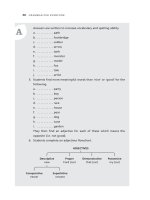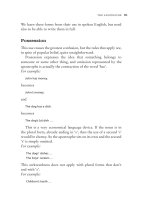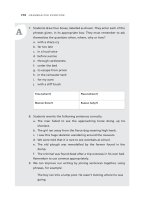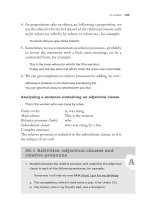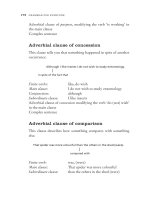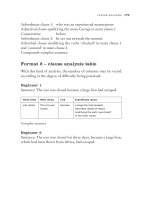Tài liệu Grammar for everyone part 8 docx
Bạn đang xem bản rút gọn của tài liệu. Xem và tải ngay bản đầy đủ của tài liệu tại đây (132.81 KB, 7 trang )
A
2.1 Activities: pronouns
1. Students rewrite sentences replacing the nouns with suitable
pronouns.
2. Students in pairs attempt to have a conversation without using any
pronouns. Suggest subjects, such as:
a. What you did yesterday …
b. A teacher reprimanding a student for a bad piece of work …
3. Students are given cloze sentences with a choice of pronouns for
filling the gaps.
a. Who drove the car? David drove . . . . . . . . . . (them, it, his, we)
b. Who gave Lucy the chewing gum? . . . . . . . . . . did. (him, those,
he, this)
c. We saw . . . . . . . . . . at the show. (I, they, him, us)
d. David bought . . . . . . . . . . ice-creams. (he, they, us, this)
e. Jenny was at the show. Did . . . . . . . . . . see . . . . . . . . . . (them,
her, we, you)
4. Students make example sentences using pronouns correctly, orally,
on the board or in their grammar exercise books.
39
p ro no un s
C
A
5. Choose pronouns to fill in the blanks.
a. Michael gave . . . . . . . . . . some of . . . . . . . . . .
b. . . . . . . . . . . really enjoyed . . . . . . . . . .
c. . . . . . . . . . . were ripe and juicy.
d. So . . . . . . . . . . gave . . . . . . . . . . to Bella.
e. . . . . . . . . . . enjoyed it too.
f. . . . . . . . . . . said . . . . . . . . . . was the best . . . . . . . . . . had ever
had.
g. Shall . . . . . . . . . . go and get more of . . . . . . . . . .?
h. Yes . . . . . . . . . . is a good idea.
i. Let . . . . . . . . . . go now.
j. . . . . . . . . . . can take this basket to carry . . . . . . . . . .
6. Students draw a flowchart for pronouns showing personal pronouns
and demonstrative pronouns. Further categories can be added as
they are learnt.
Checklist: pronouns
Students should now be able to:
• give the meaning of the word ‘pronoun’
• define the word pronoun – what is a pronoun? (with emphasis on
the point that a pronoun takes the place of a noun, so the noun is
not mentioned)
• explain why we have pronouns in our language
• pick out or mark the nouns in a given passage
• replace nouns with pronouns in a given passage
PRONOUNS
Personal
we
Demonstrative
this
40
G rA MM Ar f or eVe rY one
Verbs
We can’t do without them!
Definition: The word ‘verb’ comes from the Latin verbum meaning
‘word’. Verbs are doing, being or having words.
Before learning about verbs, students should:
• understand the term ‘noun’
• recognise common and proper nouns
• understand the term ‘pronoun’
• recognise most personal pronouns
• be able to explain their purpose
It is a good idea to teach verbs next, as a noun or pronoun
together with a verb, can form a complete sentence. This proves
most satisfactory for the student.
Care should be taken by the teacher to proceed to each new
section or concept only when the previous one has been fully
grasped. The order of the segments has been chosen carefully to
provide a sound structure of understanding.
For example, the section on finite and non-finite verbs comes
naturally at the end of the first section. However, teachers may
judge the timing of teaching this, depending on students’ level of
understanding. It should not be left too long. A simple way of
expressing it would be that a verb must have a doer (i.e. a subject)
for it to make sense.
Finite and non-finite verbs
A verb needs a noun (or a pronoun) in front of it for it to make
sense.
3
41
A
For example:
John waves.
The load slipped.
Verbs are of two kinds, non-finite or finite. Non-finite means
not complete. Non-finite verbs are not complete, because they do
not have a subject, that is, the person or thing that does the action,
or that the sentence is about. For more about the subject see
page 92.
Non-finite verbs also do not show a sense of time, i.e. tense.
Finite verbs have both a subject and a tense.
For example:
I hope (present)
John hoped (past)
The most common and recognisable form of non-finite verb is
the to-infinitive.
For example:
to drink, to be, to laugh …
3.1 Activities: finite and
non-finite verbs
The recognition of action is one of the first verbal concepts that young
children grasp, so we have them thinking about things that they do,
such as breathe, eat, clap, play.
1. Students act the verbs. This can be done in teams with each person
calling out a verb for their counterpart in the other team to act. The
latter then calls out their verb for the next in the first team, until all
have had a turn.
2. Provide on paper a list of nouns plus a separate list of verbs in
random order, which students match. This, too, can be done orally
or in writing. The lists could be written side by side and students
draw lines matching the nouns to suitable verbs, for example:
42
G rA MM Ar f or eVe rY one
A
birds pedal
trees hoot
radios neigh
lions sing
dolphins blare
water roar
cyclists erupt
volcanoes grow
owls flows
3. Students are provided with a list of nouns with which to compose
sentences by adding an appropriate verb to each. This also could be
done in reverse, for example:
Noun Verb (students add)
a. the boy joked
b. snow fell
c. my uncle laughed
d. our cat scratched
e. the hose broke
f. a ghost appeared
g. the wind howled
h. my friend fell sick
i. the ship sailed
j. the horses galloped
4. Students use the present tense to indicate a habitual action, for
example:
Uncle John snores.
April brings showers.
a. Dad f. jet planes
b. my brother g. eagles
c. old cars h. ducks
d. tramps i. geese
e. dictators j. soldiers
43
V er bs
A
5. Students add nouns to the following verbs that will indicate habit
or custom, for example:
Lions – Lions roar.
a. . . . . . . . . . . beat drums
b. . . . . . . . . . . sing
c. . . . . . . . . . . leave trails
d. . . . . . . . . . . guard the building
e. . . . . . . . . . . make speeches
f. . . . . . . . . . . irons shirts
g. . . . . . . . . . . paint pictures
h. . . . . . . . . . . take money
i. . . . . . . . . . . rattles
Tense
Definition: The word ‘tense’ is from Latin tempus meaning time.
Before learning about tense, students should be able to:
• recognise nouns
• recognise pronouns and understand their purpose
• know the meaning of the word verb
• recognise verbs and name verbs
Tense is indicated whenever we use a finite verb. A useful way
to explain tense to students is by standing facing the students and
making symbolic gestures. As the direction of reading in English
is from left to right, we use a corresponding sequence. To the
students’ left we indicate something occurring in the past. Directly
in front indicates something occurring now, in the present, and to
the right something which is to happen in the future.
Past Present Future
I laughed I laugh I shall (or will) laugh
44
G rA MM Ar f or eVe rY one
A
3.2 Activities: tense
1. Students draw the tense chart in their grammar exercise books.
Provide more verbs for which students enter the correct forms on
their chart, for example:
wreck, chip, say, hurry
It will help the students if they think in terms of the verb having a
subject, for example:
Past Present Future
(word) sag
(subject) the bed sagged
sags will sag
(word) write
(subject) they wrote writes will write
Remember that many of these activities can be done orally, but
students should do some examples in their grammar exercise
books
.
2. Students are given a list of subjects to which they add their own
choice of verb, for example:
the old car the gate my friend thunder
the cow a bull the milk cart lightning
the monster slime
Students may want to add more to their sentence.
Simple and continuous verbs
These indicate whether the action of the verb is completed or still
going on. A simple verb is one in which the action is complete
within the respective tense.
For example:
I cooked, I cook, I shall cook
45
V er bs
